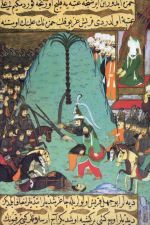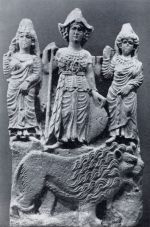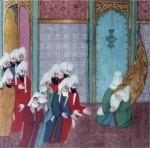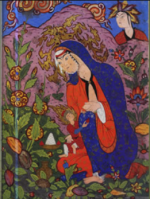Main Page: Difference between revisions
| [unchecked revision] | [unchecked revision] |
m (Added first round of cleanup to portal titles etc) |
m (More minor updates to titles and articles) |
||
| Line 50: | Line 50: | ||
<div class="articleSummaryColumnsWrapper"> | <div class="articleSummaryColumnsWrapper"> | ||
<div class="articleSummaryColumn"> | <div class="articleSummaryColumn"> | ||
{{PortalArticle|image=Battle of Badr.jpg|title=Portal: Early Islamic History|summary=The first centuries of the Islamic Hijri calendar, starting in the CE year 622, were the formative years of the religion. Between the first and third Islamic centuries the Qur'an was written down and codified, the prophet lived and died, the great hadith collections were gathered, the sira of the prophet was committed to writing, the great schools of Sunni jurisprudence came to be, and the theology of Islam attained its familiar form | {{PortalArticle|image=Battle of Badr.jpg|title=Portal: Early Islamic History|summary=The first centuries of the Islamic Hijri calendar, starting in the CE year 622, were the formative years of the religion. Between the first and third Islamic centuries the Qur'an was written down and codified, the prophet lived and died, the great hadith collections were gathered, the sira of the prophet was committed to writing, the great schools of Sunni jurisprudence came to be, and the theology of Islam attained its familiar form. These years thus can be said to cover the formation of the religion of Islam as we know it today. |description= | ||
<div style="padding: 4px;padding-left: 8px; padding-right: 8px;background: #283763; border: 1px solid #DEB330; color:#ffffff; font-size: 1.2em;">'''Sections'''</div> | <div style="padding: 4px;padding-left: 8px; padding-right: 8px;background: #283763; border: 1px solid #DEB330; color:#ffffff; font-size: 1.2em;">'''Sections'''</div> | ||
<div style="column-count:2;-moz-column-count:2;-webkit-column-count:2"> | <div style="column-count:2;-moz-column-count:2;-webkit-column-count:2"> | ||
| Line 60: | Line 60: | ||
*[[Dihya the Berber Queen (Al-Kaahina)]] | *[[Dihya the Berber Queen (Al-Kaahina)]] | ||
*[[Battle of Badr]] | *[[Battle of Badr]] | ||
*[[List of expeditions of Muhammad]] | |||
*[[The Massacre of the Banu Qurayza]] | |||
</div> | </div> | ||
}} | }} | ||
| Line 72: | Line 74: | ||
*[[Textual History of the Qur'an]] | *[[Textual History of the Qur'an]] | ||
*[[Sana'a Manuscript]] | *[[Sana'a Manuscript]] | ||
*[[ | *[[Pagan Origins of Islam]] | ||
*[[ | *[[Black Stone]] | ||
</div>}}{{PortalArticle|image=Islamic Tradition.jpg|title=Portal: Qur'an, Hadith, and Scholars|summary= | </div>}}{{PortalArticle|image=Islamic Tradition.jpg|title=Portal: Qur'an, Hadith, and Scholars|summary= The Qur'an, Hadith, Scripture pages are a special category of pages here at WikiIslam. Rather than being encyclopedia articles, these pages bring together a unique collection of Quranic verses, hadith, sira traditions, tafsir, writings of classical scholars and rulings of contemporary Islamic sheikhs and ulemaa. These pages are organized by theme to assist the student, searcher or researcher. |description= | ||
<div style="padding: 4px;padding-left: 8px; padding-right: 8px;background: #283763; border: 1px solid #DEB330; color:#ffffff; font-size: 1.2em;">'''Sections'''</div> | <div style="padding: 4px;padding-left: 8px; padding-right: 8px;background: #283763; border: 1px solid #DEB330; color:#ffffff; font-size: 1.2em;">'''Sections'''</div> | ||
<div style="column-count:2;-moz-column-count:2;-webkit-column-count:2"> | <div style="column-count:2;-moz-column-count:2;-webkit-column-count:2"> | ||
| Line 87: | Line 89: | ||
*[[Qur'an, Hadith and Scholars:Textual History of the Qur'an|Textual History of the Qur'an]] | *[[Qur'an, Hadith and Scholars:Textual History of the Qur'an|Textual History of the Qur'an]] | ||
*[[Qur'an, Hadith and Scholars:Apostasy|Apostasy]] | *[[Qur'an, Hadith and Scholars:Apostasy|Apostasy]] | ||
*[[Qur'an, Hadith and Scholars:Stoning|Stoning]] | |||
*[[Qur'an, Hadith and Scholars:Homosexuality|Homosexuality]] | *[[Qur'an, Hadith and Scholars:Homosexuality|Homosexuality]] | ||
*[[Qur'an, Hadith and Scholars: | *[[Qur'an, Hadith and Scholars:Witchcraft and the Occult|Witchcraft and the Occult]] | ||
*[[Qur'an, Hadith and Scholars:Dhimma|Dhimma]] | |||
</div>}} | </div>}} | ||
{{PortalArticle|image=Quran_Mashaf_Comparisons.jpg|title=Portal: Islamic Scriptures|summary=The idea of scripture is central to Islam; above all else, Islam's own scriptures tell of how Allah has periodically given his followers books throughout the ages, and refers to Islam's co-abrahamic religionists as People of the Book. The central scripture of Islam is above all the Qur'an, which orthodox Sunni and Shi'i Islam see as the literal word of Allah through his messenger Muhammad. |description= | {{PortalArticle|image=Quran_Mashaf_Comparisons.jpg|title=Portal: Islamic Scriptures|summary=The idea of scripture is central to Islam; above all else, Islam's own scriptures tell of how Allah has periodically given his followers books throughout the ages, and refers to Islam's co-abrahamic religionists as People of the Book. The central scripture of Islam is above all the Qur'an, which orthodox Sunni and Shi'i Islam see as the literal word of Allah through his messenger Muhammad. |description= | ||
| Line 101: | Line 105: | ||
*[[Naskh (Abrogation)]] | *[[Naskh (Abrogation)]] | ||
*[[Sahih Bukhari]] | *[[Sahih Bukhari]] | ||
*[[Asbab al-Nuzul (Revelational Circumstances of the Quran)]] | |||
</div> | </div> | ||
}} | }} | ||
| Line 224: | Line 229: | ||
</div> | </div> | ||
<div style="padding: 4px;padding-left: 8px; padding-right: 8px;background: #283763; border: 1px solid #DEB330; color:#ffffff; font-size: 1.2em;">'''Popular Articles'''</div><div style="column-count:2;-moz-column-count:2;-webkit-column-count:2"> | <div style="padding: 4px;padding-left: 8px; padding-right: 8px;background: #283763; border: 1px solid #DEB330; color:#ffffff; font-size: 1.2em;">'''Popular Articles'''</div><div style="column-count:2;-moz-column-count:2;-webkit-column-count:2"> | ||
*[[Seven Sleepers of Ephesus in the Quran]] | |||
*[[Mary, Sister of Aaron]] | *[[Mary, Sister of Aaron]] | ||
*[[Virgin Conception of Jesus in the Qur'an]] | *[[Virgin Conception of Jesus in the Qur'an]] | ||
Revision as of 18:10, 25 February 2021
- A number of transformative steps have been undertaken as part of an ongoing effort to improve the content, professionalism, and reliability of WikiIslam..read more
- Help Wanted: Contribute Today
The first centuries of the Islamic Hijri calendar, starting in the CE year 622, were the formative years of the religion. Between the first and third Islamic centuries the Qur'an was written down and codified, the prophet lived and died, the great hadith collections were gathered, the sira of the prophet was committed to writing, the great schools of Sunni jurisprudence came to be, and the theology of Islam attained its familiar form. These years thus can be said to cover the formation of the religion of Islam as we know it today.
Islam arose in 7th century Arabia, and as such its appearance bears the markings of its ancient Arab and Near East milieu.
The Qur'an, Hadith, Scripture pages are a special category of pages here at WikiIslam. Rather than being encyclopedia articles, these pages bring together a unique collection of Quranic verses, hadith, sira traditions, tafsir, writings of classical scholars and rulings of contemporary Islamic sheikhs and ulemaa. These pages are organized by theme to assist the student, searcher or researcher.
The idea of scripture is central to Islam; above all else, Islam's own scriptures tell of how Allah has periodically given his followers books throughout the ages, and refers to Islam's co-abrahamic religionists as People of the Book. The central scripture of Islam is above all the Qur'an, which orthodox Sunni and Shi'i Islam see as the literal word of Allah through his messenger Muhammad.
Islamic law, or the Shariah, is held to comprise the specific rulings intended by Allah for all of mankind in all times and places and delivered through Islamic scriptures (namely, the Quran and hadith). Fiqh, or Islamic jurisprudence, comprises the legal and interpretive theories through which these rulings are derived from the Quran and hadith. Norms observed and prescribed by Muhammad in these scriptures are, as a rule, taken literally and considered binding.
There is much in Islamic scripture that is not of direct legal relevance and which can be understood as constituting doctrine. The Arabic word aqeedah, or creed, has generally been understood to encompass a more limited range of ideas than what, to a modern person, would appear as Islamic doctrine.
Among the many and diverse matters discussed in or touched upon by Islamic scriptures are topics of direct or indirect scientific interest. These topics include reproductive science, embryology, cosmology, and medicine, among others.
While some modern Islamic scholars have struggled to reconcile Islamic law and modern, largely Western notions of human rights, the majority of traditional Islamic scholars today have defied what they perceive as an attempt at intellectual colonialism.
Muhammad, the founder of Islam, is one of the most vigorously revered men to have ever lived. His legacy has meant many different things to many different people throughout history. Information on his life comes almost exclusively through oral reports (hadiths) compiled, for the most part, more than a hundred and fifty years after his death.
The wives of the prophet are described as "أمهات المؤمنين" or "mothers of the believers." As such the prophetic example is considered instructive for all Muslim households. How the prophet interacted with his wives, and how they obeyed him, is a framework for how Muslim husbands and wives ought to interact, as well as how men should interact with their own female slaves.
Muhammad's contemporaries, companions, and successors play an elevated role in the lore of Islam. It is against many of his contemporaries that Muhammad defined his movement, it is through his companions that his tradition was passed forth, and it is by his immediate successors that his legacy was interpreted and formalized.
The Qur'an makes constant reference to the stories of the Judeao-Christian tradition. The references are familiar and sometimes in passing, and assume a great deal of familiarity on the part of the listeners. The audience for these chapters was clearly one well-acquainted with the stories themselves and the Qur'an itself says that it is a "reminder" (73:19) of the message which has come before
|












